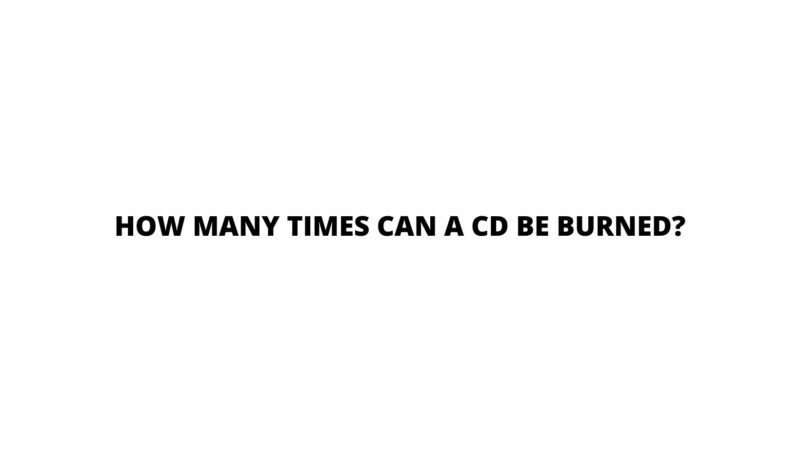Compact Discs (CDs) have been an enduring medium for storing and sharing data, and their adaptability continues to raise questions about their capabilities. One such inquiry centers on the number of times a CD can be burned before reaching its limit. This article delves into the intricacies of CD burning, the factors influencing the burn limit, the implications of multiple burns, and strategies to maximize the utility of CDs in the era of evolving data storage.
- Demystifying CD Burning
Before exploring the complexities of the burn limit, it’s essential to grasp the essence of CD burning. CD burning is the process of recording digital data onto a blank CD-R (Compact Disc-Recordable) using a laser. This process creates microscopic pits and lands on a dye layer within the disc, encoding binary data. These pits and lands are read by CD players and drives to retrieve the recorded information.
- The Question of Burn Limit
The notion of a burn limit arises from the belief that a CD has a finite number of times it can be written on. This perception stems from the understanding that each burn cycle subjects the dye layer to stress due to the laser’s energy. However, it’s crucial to differentiate between CD-Rs and CD-RWs (Compact Disc-Rewritable). CD-RWs are specifically designed for multiple writes, while CD-Rs are intended as write-once media.
- The Role of Dye Layers
The dye layer within a CD-R disc is a critical component that undergoes changes during each burn cycle. When the laser heats the dye, it creates pits and lands that represent binary data. High-quality CD-R discs have dye layers that are designed to endure multiple burn cycles without significant degradation. The dye’s stability and resistance to wear play a central role in determining the burn limit.
- Variables Influencing the Burn Limit
The number of times a CD can be burned is influenced by various factors:
- Dye Quality: High-quality dye layers are more resilient to degradation from repeated heating and cooling cycles, allowing for more burn cycles.
- Manufacturing Standards: CD-Rs manufactured with precision tend to have dye layers that can withstand more burn cycles, contributing to longevity.
- Burn Speed: Burning data at higher speeds generates more heat, potentially impacting the dye layer’s integrity. Slower burn speeds can extend the burn limit.
- Environmental Factors: Storage conditions, including temperature, humidity, and exposure to light, can affect the dye layer’s stability and the overall burn limit.
- Handling Practices: Careful handling to prevent physical damage, such as scratches, can minimize wear on the dye layer.
- Addressing the Burn Limit Myth
The concept of a strict burn limit is a bit of a misnomer. While each burn cycle does subject the dye layer to stress, the practicality of the limit depends on the quality of the dye layer, manufacturing standards, and handling practices. Reputable manufacturers design CD-Rs with dye layers that can withstand numerous burn cycles, making the notion of a fixed limit less relevant.
- Maximizing CD-R Utilization
To make the most of CD-R discs and potentially extend their usability, consider the following strategies:
- Select Quality Discs: Opt for CD-R discs from reputable manufacturers known for producing reliable and durable products.
- Manage Burn Speed: Choose lower burn speeds to reduce the stress on the dye layer and enhance its longevity.
- Practice Proper Storage: Store CD-R discs in controlled environments to minimize factors that contribute to dye layer degradation.
- Implement Regular Backups: Create backups of CD-R data on alternative storage solutions to mitigate the risk of data loss due to potential dye layer wear.
- The Evolution of Data Storage
While the burn limit of CD-Rs continues to be a topic of discussion, it’s essential to recognize the broader landscape of data storage solutions. Technological advances have introduced alternatives such as solid-state drives (SSDs), cloud storage, and high-capacity USB drives. These solutions offer benefits like faster data access, increased storage capacities, and enhanced durability.
- Future Prospects
As technology progresses, the question of the CD burn limit may evolve. Research and innovation may lead to the development of CD-R technology that offers even greater endurance and flexibility.
Conclusion
The burn limit of CD-R discs reflects a dynamic interplay between material science, manufacturing standards, and user practices. CD-Rs have served as reliable data storage solutions for decades, adapting to changing technological landscapes. While the idea of a strict burn limit may not hold true due to the variability of factors, it’s crucial to recognize the potential for multiple burn cycles.
By selecting quality CD-Rs, practicing proper storage and handling, and considering alternatives for long-term data preservation, users can make the most of this versatile storage medium. The question of how many times a CD can be burned remains a testament to the enduring relevance of CDs in the ever-evolving world of digital data storage.


